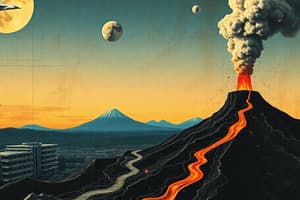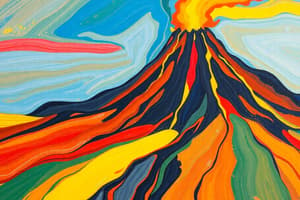Podcast
Questions and Answers
What is the main characteristic of shield volcanoes?
What is the main characteristic of shield volcanoes?
Which type of volcano is more prone to destructive explosions?
Which type of volcano is more prone to destructive explosions?
What gives stratovolcanoes their name?
What gives stratovolcanoes their name?
Which volcano is known for its large pyroclastic flows and ash cloud expulsions?
Which volcano is known for its large pyroclastic flows and ash cloud expulsions?
Signup and view all the answers
Why are shield volcanoes less prone to destructive explosions compared to stratovolcanoes?
Why are shield volcanoes less prone to destructive explosions compared to stratovolcanoes?
Signup and view all the answers
What is a characteristic of calderas?
What is a characteristic of calderas?
Signup and view all the answers
What are lahars?
What are lahars?
Signup and view all the answers
How do ash clouds generated by explosive eruptions pose risks to aviation safety?
How do ash clouds generated by explosive eruptions pose risks to aviation safety?
Signup and view all the answers
What is a significant impact of lava flows during volcanic eruptions?
What is a significant impact of lava flows during volcanic eruptions?
Signup and view all the answers
Why is it important to monitor active volcanoes and prepare emergency response plans?
Why is it important to monitor active volcanoes and prepare emergency response plans?
Signup and view all the answers
Study Notes
Volcanoes are geological phenomena that occur when molten rock called magma rises from beneath the Earth's surface. They can be found all over the world, with some areas more prone to eruptions due to tectonic plate movements and other factors. There are several different types of volcanoes, each with its own characteristics and associated hazards.
Types of Volcanoes
There are three main types of volcanoes based on their location and formation process:
Shield Volcanoes
Shield volcanoes are characterized by gentle slopes and a broad base. They are formed by low viscosity lava flows, which tend to flow outwards rather than building upwards like with other types of volcanoes. This makes them less prone to destructive explosions compared to other types of volcanoes. Examples of shield volcanoes include Kilauea in Hawaii and Mount Etna in Italy.
Stratovolcanoes
Stratovolcanoes have steep slopes and typically form conical peaks because they build up slowly, layer upon layer, through multiple eruptions. Their name is derived from the Japanese term 'strato', meaning layer, referring to the layers of ash and debris that accumulate around these volcanoes over time. Eruptions of stratovolcanoes can be both explosive and effusive, leading to large pyroclastic flows and the expulsion of ash clouds. Some famous examples include Mount Fujiyama in Japan and Mount St. Helens in Washington State, USA.
Calderas
Calderas are large craters caused by massive eruptions where the ground collapses after the removal of a large volume of material during an eruption. These features can range in size and shape, depending on the amount of material removed. One example is Yellowstone National Park in Wyoming, which hosts one of the largest calderas in North America.
Volcanic Hazards
Volcanoes present numerous risks to communities and ecosystems located near them. Some of the most severe hazards associated with volcanic activity include:
Lahars
Lahars, also known as pyroclastic flows or mudflows, are fast-moving mixtures of volcanic materials mixed with water from rainfall, melting snow or ice. When triggered by events such as earthquakes or eruptions, lahars can cause widespread destruction, burying everything in their path.
Ash Clouds
Explosive eruptions can generate dense ash clouds that can reach high altitudes, posing risks to aviation safety. Ash clouds can damage aircraft engines and interfere with visibility, making flying dangerous. In addition, heavy ash deposits can disrupt agricultural activities and harm wildlife.
Lava Flow
Hot, fluid lava flows down the sides of a volcano during an eruption. While slow-moving, lava flows can consume anything in their path, including buildings, forests, and even entire towns.
In conclusion, understanding the various types of volcanoes and the hazards they pose is crucial for mitigating potential damages to human populations and ecosystems. Monitoring active volcanoes, preparing emergency response plans, and enforcing evacuation measures when necessary are essential steps towards effectively managing the threats presented by these natural geologic wonders.
Studying That Suits You
Use AI to generate personalized quizzes and flashcards to suit your learning preferences.
Description
Explore the different types of volcanoes such as shield, stratovolcanoes, and calderas, along with the associated hazards like lahars, ash clouds, and lava flows. Learn about their formation processes, characteristics, and the risks they pose to communities and ecosystems.




